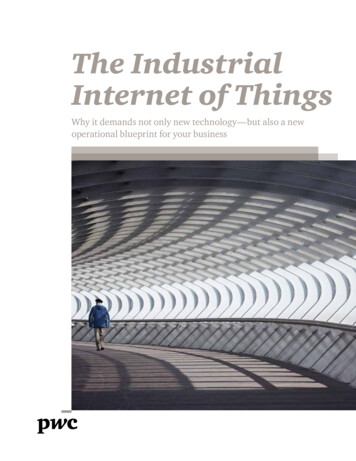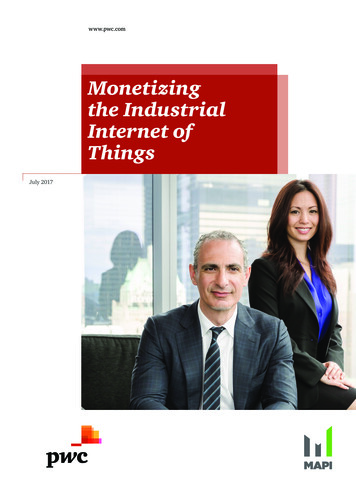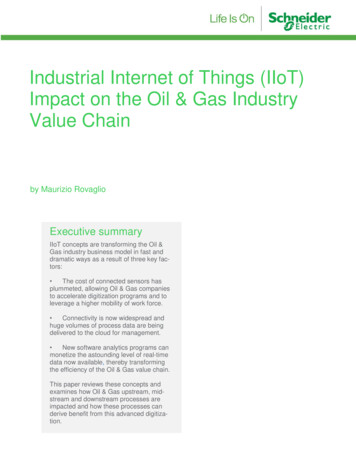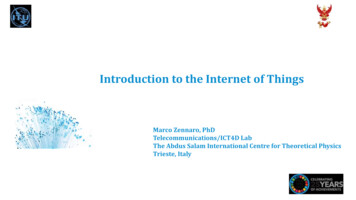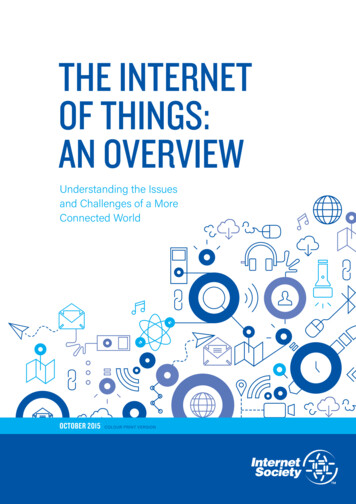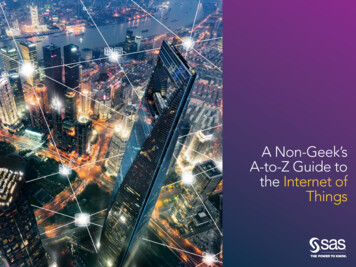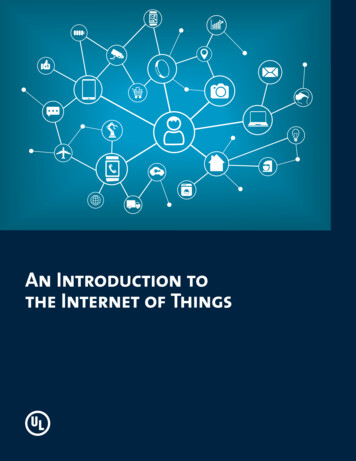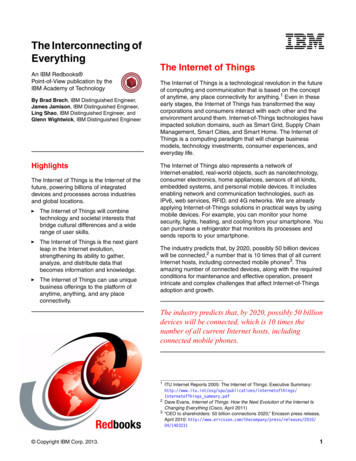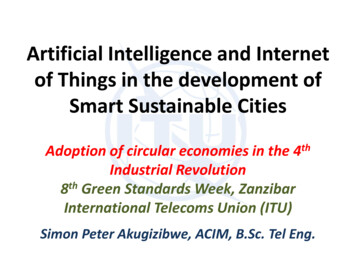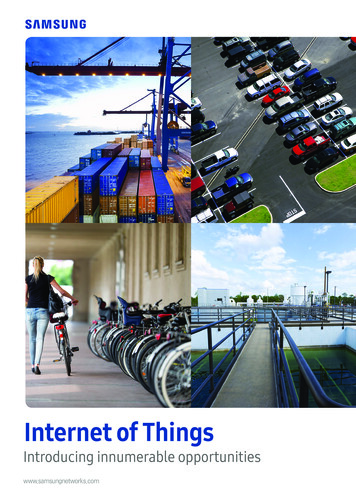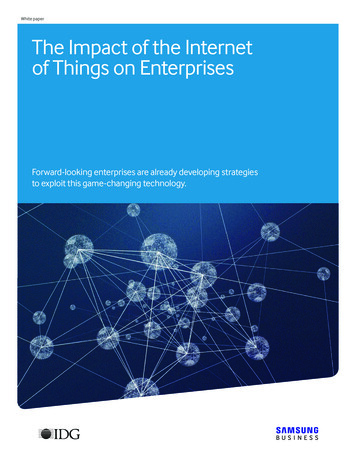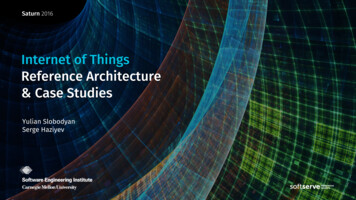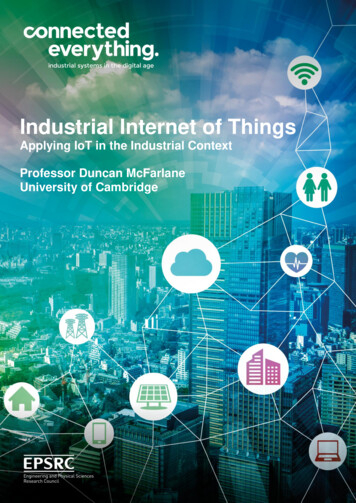
Transcription
Industrial Internet of ThingsApplying IoT in the Industrial ContextProfessor Duncan McFarlaneUniversity of Cambridge
Contents1. Summary32. Internet of Things32.1 Definition and interpretation of IoT32.2 Background to IoT42.3 Vision42.4 IoT Functionality52.5 Links to Internet62.6 Uses of IoT63. Industrial IOT73.1 Definition of Industrial IoT73.2 Uses of Industrial IoT73.3 Links to existing Industrial IT93.4 Links to other industrial paradigms103.5 Industrial IoT Research and Development113.6 Research Challenges in IIoT122
SummaryThe brief report provides a positioning ofdevelopments in the area referred to as IndustrialInternet of Things (IIoT) – loosely interpreting this asthe industrial developments associated with theInternet of Things (IoT). IoT in turn describes theextension of the application of internetcommunications beyond computers and networkeddevices to also include the networking of everydayobjects. In the context of industrial operations theseobjects are typically equipment, products and rawmaterials.The Industrial Internet of Things is not a welldocumented field at present and, as a consequence,this report begins with an overview of the Internet ofThings as a whole in Section 1. In Section 2 thosedevelopments are specialised to consider issuesspecifically relevant to Industrial IoT. The report alsopositions Industrial IoT in the context of otherindustrial digitalisation initiatives currently receivingindustrial and academic attention.Finally, research directions in the areas of Sensorsand Actuators, Communications, Infrastructure,Integration, Standardisation and Economics areproposed.This report is not intended to be comprehensive andrepresents the author's view on the meaning andstate of Industrial IoT.A webinar which accompanies the report is locatedat:http://www.youtube.com/watch?v pj8ApxsymB4&feature youtu.be2. Internet of Thingsconnecting objects (via sensing) so that datagathered about them might be used to analyse,interpret, decide and act on that data and otherassociated information.According to TechTarget’s Internet of ThingsNetwork Internet it is defined as follows:The Internet of Things, or IoT, is a system ofinterrelated computing devices, mechanical anddigital machines, objects, animals or people that areprovided with unique identifiers (UIDs) and the abilityto transfer data over a network without requiringhuman-to-human or human-to-computer interaction.data.aAdditional definitions by organisations such as IEEEand OASIS provide the same sense of IoT being amechanism for connecting physical items to theinternet:A network of items—each embedded with sensors—which are connected to the Internet.bA system where the Internet is connected to thephysical world via ubiquitous sensors.cIn its simplest form, IoT is generally understood tocomprise three key component levels (see a recentIEEE IoT paperd, GS1s Internet of Things Reporteand also the 2015 IEEE Report on Definitions of IoT fand the references therein):1.Edge functionality – sensors (and actuators)connected to physical objects and machines.2.Data Gateways – mechanisms for receivingsensed data from edge devices and transmittingto edge devices. Also capable of transmitting andreceiving information from networked servers.3.Data Management & Analysis – (cloud) serverbased collection, linking, analysis and use ofdata.2.1 Definition and interpretation of IoTThe Internet of Things (IoT) is one of the mostwidely used phrases in modern computingdevelopments. Although often referred to as atechnology, it is more accurately a platform foraTech Target’s Internet of Things Network, definition/Internet-ofThings-IoTb IEEE, Special Report: The Internet of Things, port-the-internet-of-thingsc OASIS, Open Protocols, 2014d Chen, S., Xu, H., Liu,D., Hu, B. and Wang, H. A vision of IoT:Applications, Challenges and Opportunities with China Perspective,IEEE Internet of Things Journal, 1, 349ff, 2014e Barthel, H. et al, GS1 and the Internet of Things, Release 1.0,2016f Minerva, R., Biru, A., and Rotondi, D. IEEE Report, Towards adefinition of the Internet of Things (IoT), Revision 1, 20153
Connecting these levels are the necessarycommunication systems. Edge to Gatewaycommunications are supported by a myriad of wiredand wireless communication methods (see Section2.3).Figure 1: Conceptual of Schematic IoTThere are some common attributes of IoT as well assome misconceptions. These are summarised inTable 1.IoT Enabling infrastructure A means forconnecting objects toother objects ofmachines Extension of Internet(to include objects) Enabling sensing,decisions and actionsinvolving everydayobjectsNot IoT An application or aservice A new separatenetwork of objects Just about gettingobject data fromsensors2.2 Background to IoTThe phrase Internet of Things is attributed to Proctorand Gamble Marketing Director Kevin Ashtong, whoin 1999 was working with P&G to link their enterprisecomputing systems to an automated form of productdata collection based around RFID (RadioFrequency Identification). Ashton noted that a majorlimitation of computing, at the time, was that all dataneeded to be collected manually.At the time, products such as RFID were used toenable remote data sensing. Auto ID Centerhdeveloped a new radical approach to very low costRFID. Rather than house product data (expensively)in the memory on the RFID tag itself, the tagmemory was simply provided with an identificationnumber which when read would provide a link tofurther product data being (cheaply) stored onnetworked servers. As a result a commercial productfollowing such a process would thus be linked to itsdata via an internet connection, further reinforcingthe notion of an internet of things.2.3 VisionAlthough many of the commercial partners in thisprogramme were simply seeking a like for likereplacement for barcodes (albeit with better readingdistances, rates and fewer line of sight constraints)the vision that evolved around these developmentswas rather more ambitious. In 1999 the MIT lab wasactivity seeking to use this RFID model to enable, forexample, food products to communicate interactivelywith cooking equipment (see Figure 2). Mainly about big data Mainly about database coordinationTable 1: IoT AttributesFigure 2: Food product interacting withequipment (Reworking of Auto ID Centergraphic, 2000)gAshton provides an explanation of this in Ashton, K. That Internetof Things Thing, RFID Journal, June, 2009h Auto ID Center ran a research programme examining electronicalternatives to the Bar Code, initiated at MIT in 1999, involving 100 companies, University of Cambridge and Adelaide University andlater University of St Gallen, Keio University, Fudan University andKAIST.4
This notion of products being equipped with anability to interact was formalised in 2002 with theintroduction of a specification for an intelligentproducti.An intelligent product is one which:1. Possesses a unique identity2. Is capable of communicating effectively with itsenvironment3. Can retain or store data about itself4. Deploys a language to display its features,production requirements etc.Figure 3: Different IoT Communications Approachesm2. Gateways: Many devices can perform thefunctionality required from a gateway asdescribed in Figure 1 ranging from networkcapable RFID readers, to mobile communicationmasts. LPWAN gateways are most commonlyreferred to as IoT gateways which is accurate butit should be noted that these represent a smallsubsection of potential IoT traffic.5. Is capable of participating in or making decisionsrelevant to its own destiny2.4 IoT FunctionalityReferring to Figure 1 we make the followingcomments about some aspects of IoT operations.1. Edge – Gateway communications: Theunderlying assumption is that many suchcommunications will be wireless in nature,requiring some form of transmission/receptioncapabilities at both edge (device, sensor,actuator) and network gateway. The nature of thecommunication itself will depend on severalfactors but range and data rates will besignificant factors in selecting a particularcommunications mechanism. This is illustrated inFigure 3 and it can be seen that there are a vastrange of communication options ranging from thehigh data rates over low range of Wifi 802.11 tolow data rates and very high range [10 km]associated with the low power, wide areanetwork approaches being generally proposed byLoRa / LoRaWANj (open) and Sigfoxk(proprietary), and for specific applications, likeTexas Instrument's WMBusl for smart meteringdata collection.3. (Cloud) Servers: Because of the distributednature of the data sources, servers supportingdata management and analysis functions aretypically cloud based. Some of the key functionsrequired to support data management for IoTbased sensors and devices are outlined inFigure 4. Importantly, it is noted that dataanalytics is just one of a number of functionalitiesrequired to support IoT data. Further informationon IoT data management support can be foundIEEEs 2015 reportf.Figure 4: IoT Related Data Management SupportiWong, C. Y., McFarlane, D., Zaharudin, A. A. and Agarwal, V.(2002). The intelligent product driven supply chain. Proceedings ofthe IEEE International Conference on Systems, Man andCybernetics, 4, 393-398, 2002jA technical review of LoRa and LoRaWAN TM, 2015See https://www.sigfox.com/l See https://www.ti.com/tool/WMBUSm Source: 2016 https://www.link-labs.comk5
2.5 Links to Internet2.6 Uses of IoTThe internet was originally intended as a mechanismfor allowing computers in different locations tocommunicate in order to allow for simpleapplications such as file transfers, electronic mailetc. Although viewed as a system it is moreaccurately a collection of communication devicesand media combined in a standardised formation. Itis supported by a set of standards which allow forthe specification of communication media, protocols,data transport. In the 1990s the internet wasincreasingly used to also connect mobile devicesand increasingly powered industrial equipment wasalso accessible via internet communications (seeFigure 5). In the 2000s, the notion of inanimate(non-powered) objects also becoming part of theinternet was introduced. The main challenge wasthat these items could not directly form a networkconnection, so the use of automated identificationtechnologies (RFID, Bluetooth, bar code, QR code)provided a proxy connection – typically via someform of networked reading device. Further, in anindustrial context, the Industrial Internet Consortiumnhas expended significant efforts establishingrequirements for industrial internet applicability andthen also considering how Internet of Things fits intothis contexto.In some ways, any solution for connecting senseddata to a data base could be termed an IoT-solution,but in this section we differentiate between ad hocsolutions for object sensing, tracking, actuation thatmight be developed for a particular application,probably within one location, and those for whichsystematic IoT based architectures have beenexplicitly used. Such applications are typicallycharacterised by:1. Applications requiring multi-organisation [object]sensed-data sharing2. High variety & wide distribution of sensors /sensed data / data sources emerging3. Cloud [internet] based application software isalready in use for managing items in a particulardomain (e.g. homes, offices)4. Environments having little or no legacy datacollection and management infrastructure.To these characteristics, we add – predominantly forfuture applications:5. Applications involving personalisation /customisation of products / orders / items[‘smarter things’]Noting these characteristics, it is no surprise thatcities, homes and office environments are earlyadopters of organised IoT sensed data managementinfrastructures (see Figure 6).Figure 5: Extension of Internet: Mobile Devices,Equipment and ObjectsnoIndustrial Internet Consortium, http://www.iiconsortium.org/Industrial Internet Consortium, The Industrial Internet of ThingsVolume G5: Connectivity Framework, 2017IIC:PUB:G5:V1.0:PB:20170228.6
Figure 6: City based IoT ApplicationsFigure 7: Industrial IoT Schematic7
3. Industrial IoTGiven that in this report Industrial Internet of Things(IIoT) is loosely interpreted as the industrialapplication developments associated with theInternet of Things (IoT) the first part of the report hasnecessarily reviewed these developments. In thissecond part we interpret IoT in an industrial context,position it against other industrial digital systemsparadigms and identify challenges for research anddevelopment.3.1 Definition of Industrial IoTFollowing the comments above, the definitions to beused here simply relate to the industrial use of IoT.The term industrial Internet of things (IIoT) is oftenencountered in the manufacturing industries,referring to the industrial subset of the IoT a(i) Collecting Non-Production Data to ImproveIndustrial Operations: Industrial operations areextremely efficient at sensing production data toensure best performance but generally less efficientat integrating data from maintenance, quality controland raw material supplies into consideringproduction planning, scheduling and control issues.Part of the reason is the difficulty of integrating suchdata into the factory information & controlenvironment. IoT can potentially help address thischallenge by making this data accessible – even if itoriginates from 3rd party data suppliers. Converselythe use of production data for non-production needs(maintenance, quality control etc.) can also beenabled by some of the evolving Industrial IoTofferings. Figure 8 illustrates different "layers" ofmanufacturing data: core production data, peripheralproduction data, factory wide data, supply chain dataand ecosystem data. There is very littleinterconnection currently between these levels andthis
According to TechTarget’s Internet of Things Network Internet it is defined as follows: The Internet of Things, or IoT, is a system of interrelated computing devices, mechanical and digital machines, objects, animals or people that are provided with unique identifiers (UIDs) and the ability to transfer data over a network without requiringFile Size: 1MBPage Count: 16
